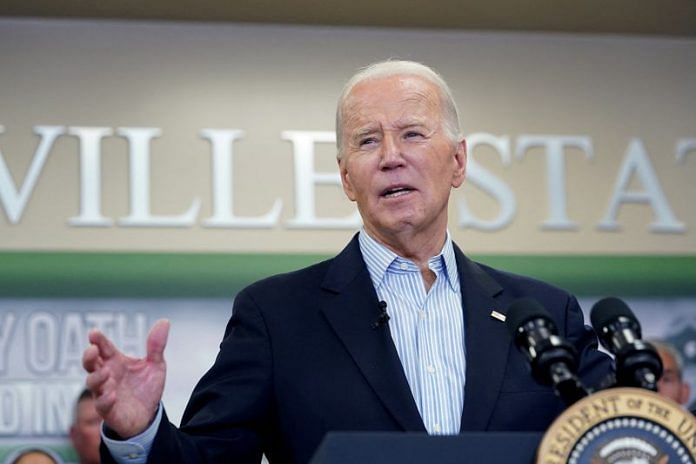By Phil Stewart, Idrees Ali and Nandita Bose
WASHINGTON (Reuters) -U.S. President Joe Biden announced on Friday plans to carry out a first military airdrop of food and supplies into Gaza, a day after the deaths of Palestinians queuing for aid threw a spotlight on an unfolding humanitarian catastrophe in the crowded coastal enclave.
Biden said the U.S. airdrop would take place in the coming days but offered no further specifics. Other countries, including Jordan and France, have already carried out airdrops of aid into Gaza.
“We need to do more and the United States will do more,” Biden told reporters, adding that “aid flowing to Gaza is nowhere nearly enough.”
At the White House, spokesperson John Kirby stressed that airdrops would become “a sustained effort.” He added that the first airdrop would be likely be military MREs, or “meals ready-to-eat.”
“This isn’t going to be one and done,” Kirby said.
Biden told reporters that the U.S. was also looking at the possibility of a maritime corridor to deliver large amounts of aid into Gaza.
The airdrops could begin as early as this weekend, officials said.
At least 576,000 people in the Gaza Strip – one quarter of the enclave’s population – are one step away from famine, according to the U.N. Office for the Coordination of Humanitarian Affairs.
Gaza health authorities said Israeli forces had killed more than 100 people trying to reach a relief convoy near Gaza City early on Thursday. Palestinians face an increasingly desperate situation nearly five months into the war that began with a Hamas attack on Israel on Oct. 7.
Israel blamed most of the deaths on crowds that swarmed around aid trucks, saying victims had been trampled or run over. An Israeli official also said troops had “in a limited response” later fired on crowds they felt had posed a threat.
With people eating animal feed and even cactuses to survive, and with medics saying children are dying in hospitals from malnutrition and dehydration, the U.N. has said it faces “overwhelming obstacles” getting in aid.
While it is unclear which type of aircraft will be used, the C-17 and C-130 are best suited for the job.
David Deptula, a retired U.S. Air Force three-star general who once commanded the no-fly zone over northern Iraq, said airdrops are something the U.S. military can effectively execute.
“It is something that’s right up their mission alley,” Deptula told Reuters.
“There are a lot of detailed challenges. But there’s nothing insurmountable.”
The United States and others also expect aid would be boosted by a temporary ceasefire, which Biden said Friday he hoped would happen by the time of the Muslim fasting month of Ramadan, which starts on March 10.
ISRAEL ‘AWARE’ OF AIRDROP
Still, there have been questions about the effectiveness of air dropping aid into Gaza.
A U.S. official, speaking on the condition of anonymity, said the airdrops would have only a limited impact on the suffering of those in Gaza.
“It doesn’t deal with the root cause,” the official said, adding that ultimately only opening up land borders could deal with the issue in a serious manner.
Another issue, the official added, was that the U.S. could not ensure that the aid simply didn’t end up in Hamas’ hands, given that the United States did not have troops on the ground.
“Humanitarian workers always complain that airdrops are good photo opportunities but a lousy way to deliver aid,” Richard Gowan, the International Crisis Group’s U.N. Director, said. Gowan said that the only way to get enough aid was through aid convoys which would follow a truce.
“It is arguable that the situation in Gaza is now so bad that any additional supplies will at least alleviate some suffering. But this at best a temporary band aid measure,” Gowan added.
Under pressure at home and abroad, another U.S. official said the Biden administration was looking at shipping aid by sea from Cyprus, some 210 nautical miles off Gaza’s Mediterranean coast.
At the White House, Kirby acknowledged that the airdrops into Gaza were “extremely difficult” because of the dense population and ongoing conflict.
The U.S. for months has been calling for Israel to allow more aid into Gaza, something Israel has resisted.
Kirby noted that Israel had tried to airdrop supplies into Gaza and it was supportive of the U.S. airdropping aid.
“We are aware of the humanitarian airdrop,” said an Israeli official in Washington.
The official, speaking on condition of anonymity, did not reply to a question on whether the U.S. had sought Israeli agreement in advance on the air drops or was coordinating the effort with it.
Biden’s announcement of the fresh aid to Gaza was marred by gaffes as he twice confused it for Ukraine.
The U.N. delivered aid to besieged northern Gaza for the first time in over a week on Friday, said the U.N. Office for the Coordination of Humanitarian Affairs. The U.N. delivered medicines, vaccines and fuel to al-Shifa hospital in Gaza City.
The World Food Programme said 10 days ago that it was pausing deliveries of food aid to northern Gaza until conditions in the Palestinian enclave allow for safe distribution.
The U.N. Palestinian refugee agency UNRWA said on Friday that during February an average of nearly 97 trucks were able to enter Gaza each day, compared with about 150 trucks a day in January, adding: “The number of trucks entering Gaza remains well below the target of 500 per day.”
(Reporting by Phil Stewart, Idrees Ali and Nandita Bose; additional reporting by Matt Spetalnick and Michelle Nichols; Editing by Rami Ayyub, William Maclean, Marguerita Choy and David Gregorio)
Disclaimer: This report is auto generated from the Reuters news service. ThePrint holds no responsibilty for its content.



